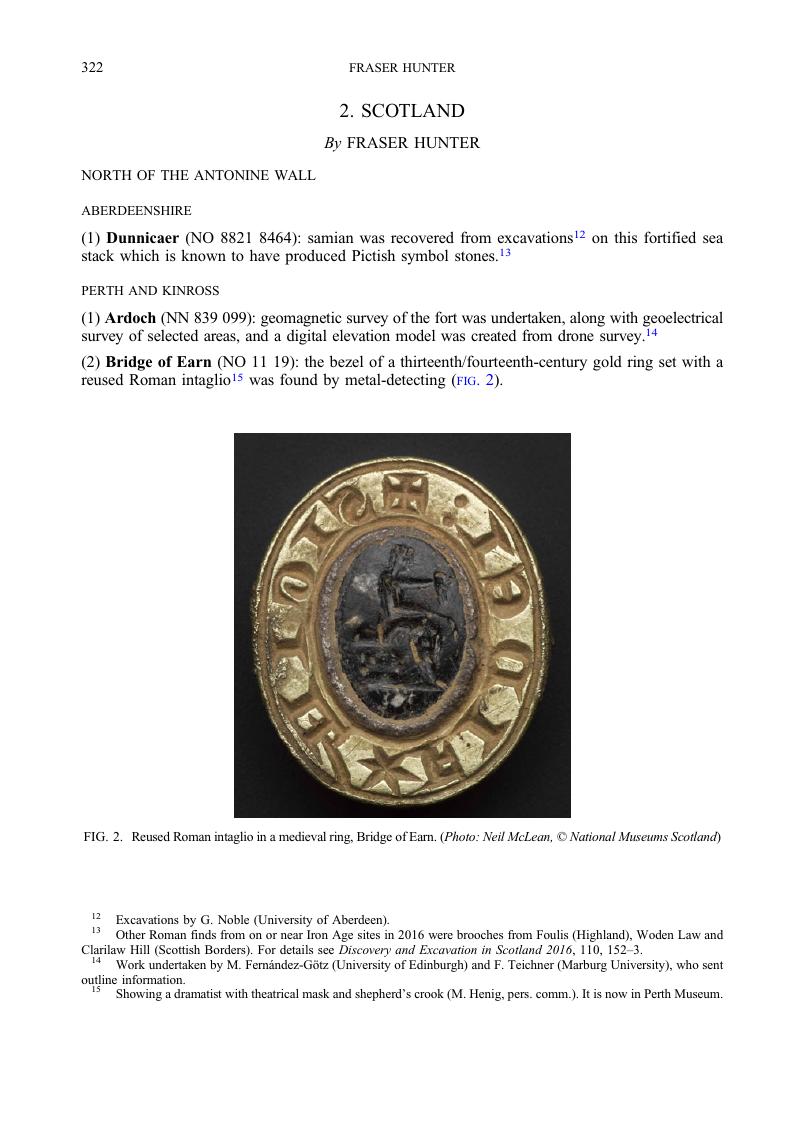No CrossRef data available.
Published online by Cambridge University Press: 14 August 2017

12 Excavations by G. Noble (University of Aberdeen).
13 Other Roman finds from on or near Iron Age sites in 2016 were brooches from Foulis (Highland), Woden Law and Clarilaw Hill (Scottish Borders). For details see Discovery and Excavation in Scotland 2016, 110, 152–3.
14 Work undertaken by M. Fernández-Götz (University of Edinburgh) and F. Teichner (Marburg University), who sent outline information.
15 Showing a dramatist with theatrical mask and shepherd's crook (M. Henig, pers. comm.). It is now in Perth Museum.
16 Excavations were led for the Treasure Trove Unit and National Museums Scotland (where the finds are housed) by Dr F. Hunter.
17 Now in St Andrews Museum. A four-ounce lead weight recovered from Boarhills (Fife) provides a further hint of contact to the area. Further stray finds of Roman brooches were reported from Loanhead (Perth and Kinross), Airth (Falkirk), Pitmilly (Fife), Luffness and Knowes (East Lothian), Cowdenknowes, Hallydown, Hassendean Bank, Maxton and Stobo (Scottish Borders). For details see Discovery and Excavation in Scotland 2016, 58, 61, 78, 85–6, 139, 150–2, 154, 156–7.
18 Jones, R.H., Roman Camps in Scotland (2011), 196Google Scholar, illus. 167.
19 Work directed by G. Bailey (who sent a report) for Falkirk Community Trust, Edinburgh Archaeological Field Society and Easter Carmuirs Primary School.
20 Led by R. Jones (University of Glasgow), who sent details.
21 A.S. Robertson, An Antonine Fort: Golden Hill, Duntocher (1957); Robertson, A.S. and Keppie, L., The Antonine Wall: a Handbook to Scotland's Roman Frontier (6th edn, 2015), 115–16Google Scholar.
22 Led by G. Bailey (who sent a report) for Falkirk Local History Society and Edinburgh Archaeological Field Society.
23 For previous work here, see Britannia 47 (2016), 293Google Scholar; for the fort, Robertson, A.S. and Keppie, L., The Antonine Wall: a Handbook to Scotland's Roman Frontier (6th edn, 2015), 64–5Google Scholar.
24 Work carried out by Canterbury Christ Church University under the auspices of the ‘Hidden Landscape of a Roman Frontier’ project by N. Hannon and D. Rohl.
25 By G. Savory of CFA Archaeology for Justin Lamb Associates.
26 A line of pits has been recorded on aerial photographs in the area, and assessed nearby previously: Discovery and Excavation in Scotland 1998, 79–80.
27 By Historic Environment Scotland; see Discovery and Excavation in Scotland 2016, 189. For the site see RCAHMS, Eastern Dumfriesshire: an Archaeological Landscape (1997), 173, 309 no. 1201Google Scholar.
28 The work was directed by J.H. Reid and A. Nicholson (who sent a summary) and funded by Heritage Lottery Fund, Trimontium Trust, Dumfriesshire and Galloway Natural History and Antiquarian Society and Mouswald Trust. For earlier work see Britannia 47 (2016), 294–7Google Scholar.
29 Information from N.M.McQ. Holmes and S. Campbell; the coins are now in Dumfries Museum.
30 Other stray finds from the vicinity of Roman sites in 2016 were a pelta-shaped scabbard chape found near the Roman road at Soutra (Midlothian) and an enamelled stud from Carstairs Mains (South Lanarkshire); see Discovery and Excavation in Scotland 2016, 119, 165.
31 Directed by Iraia Arabaolaza of GUARD Archaeology for Kier Construction.
32 Providing a long-anticipated addition to the unnaturally sparse evidence for Roman activity in the area; see Roy, W., The Military Antiquities of Roman Britain (1793), 106Google Scholar, arguing for a road to Ayr; Wilson, A., Glasgow Archaeological Journal 19 (1994–5), 1–30CrossRefGoogle Scholar, especially 13–15.
33 The only likely context for such features in this quantity is a temporary camp; see Jones, R.H., Roman Camps in Scotland (2011), 81–3Google Scholar.